Abstract
Feeding of a protein antigen to adult mice results in reduced humoral and cell-mediated immune (CMI) responses when that antigen is subsequently presented, and also causes activation of suppressor cells in the gut-associated lymphoid tissues (GALT). We have attempted to abrogate this tolerance to fed antigen by pretreating mice with 100 mg/kg cyclophosphamide before oral immunization and challenge with ovalbumin. Cyclophosphamide-pretreated mice did not develop serum haemagglutinating antibodies, nor systemic CMI (as assessed by skin testing) after ovalbumin feeding. However, evidence that CMI had been induced in the GALT was provided by the significant inhibition of migration and mesenteric lymph node cells from cyclophosphamide-pretreated animals, but not from other control groups. in the presence of ovalbumin. Our previous work on CMI reactions in the small intestine has shown that the cell production rate in the crypts of Lieberkuhn and the intraepithelial lymphocyte count are reliable although indirect measures of mucosal CMI. Cyclophosphamide-pretreated, ovalbumin-immunized animals, which had been fed 0 . 1 mg ovalbumin daily for 10 days before killing, had increased crypt cell mitoses, and increased intraepithelial lymphocyte counts, indicating the presence of mucosal CMI response to ovalbumin. Mechanisms whereby cyclophosphamide pretreatment leads to abrogation of tolerance and induction of mucosal CMI are discussed.
Full text
PDF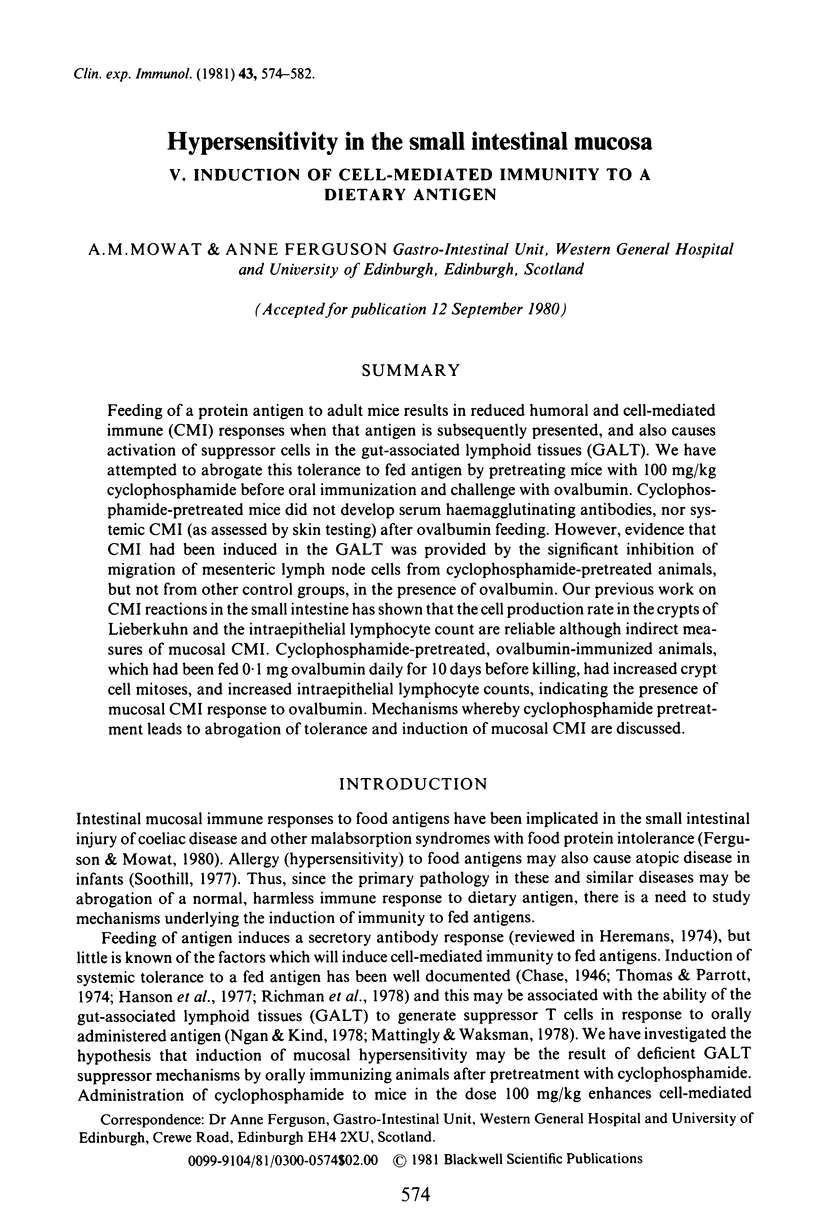
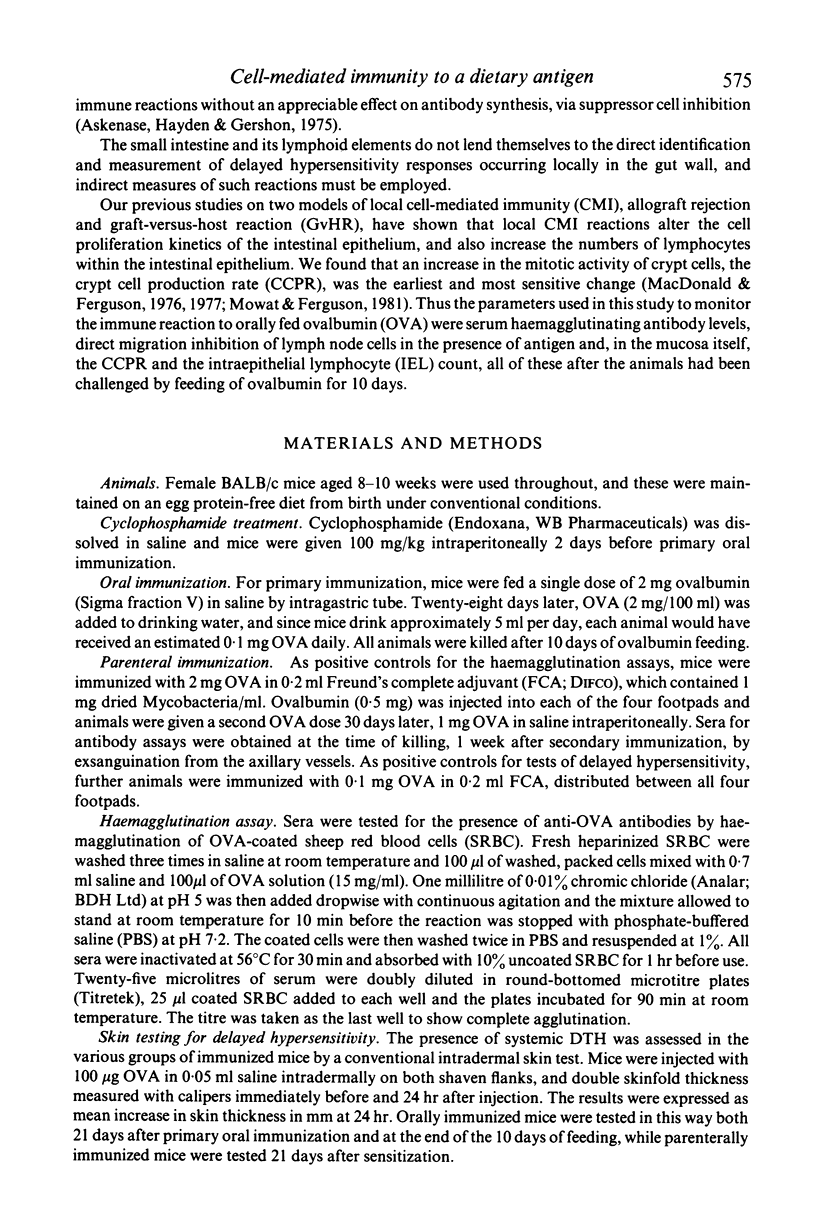

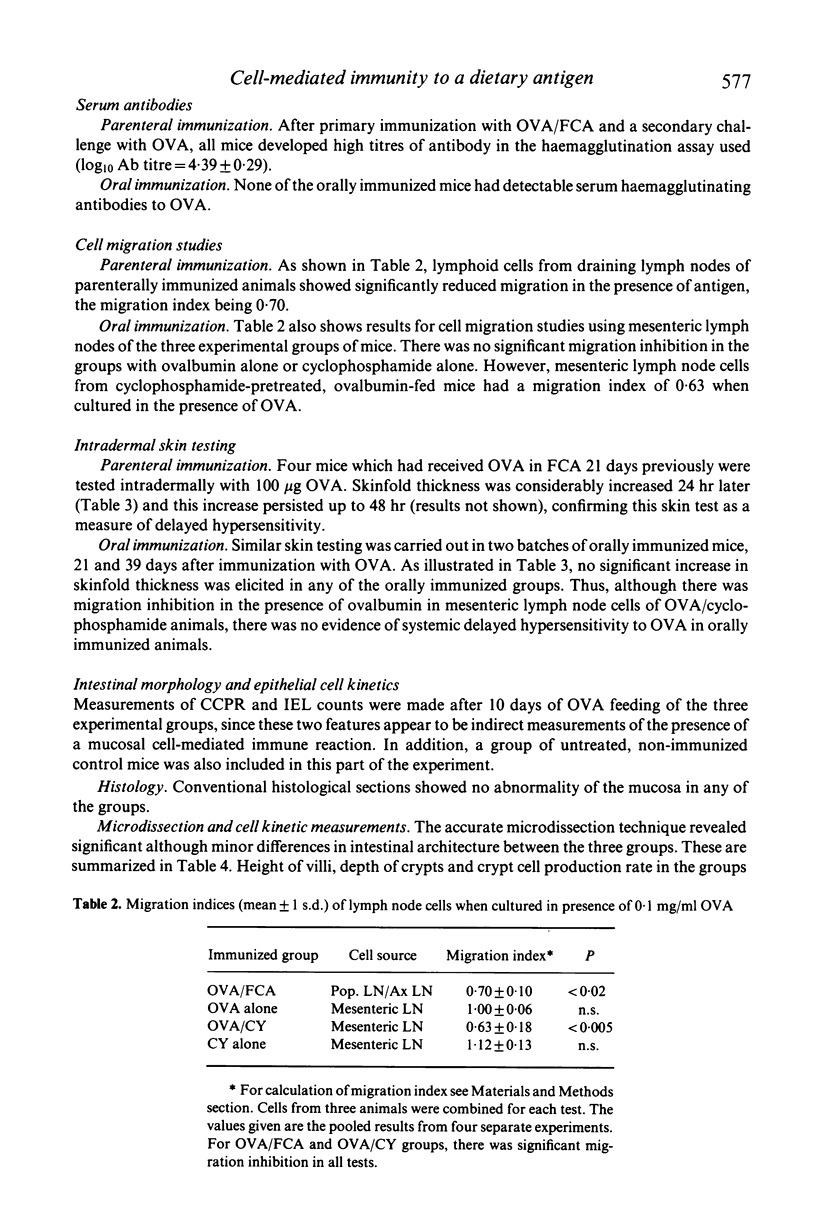
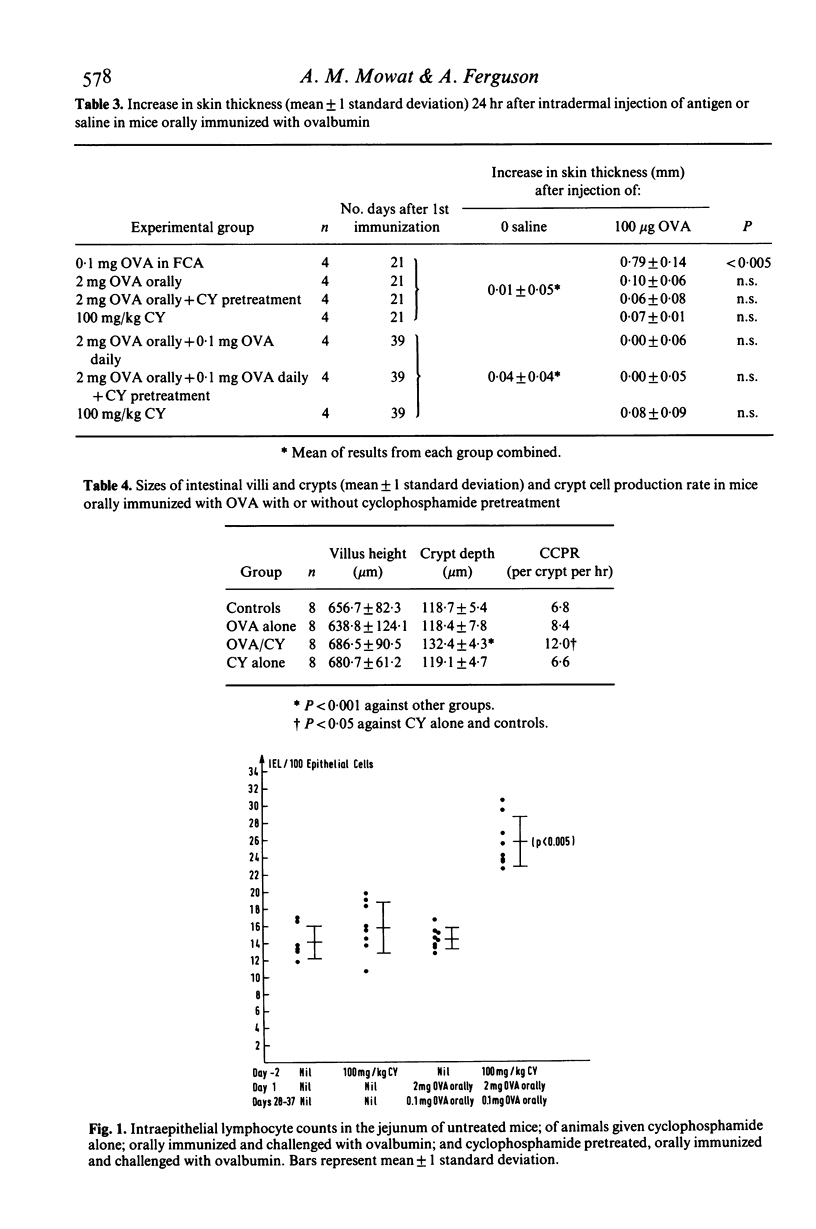
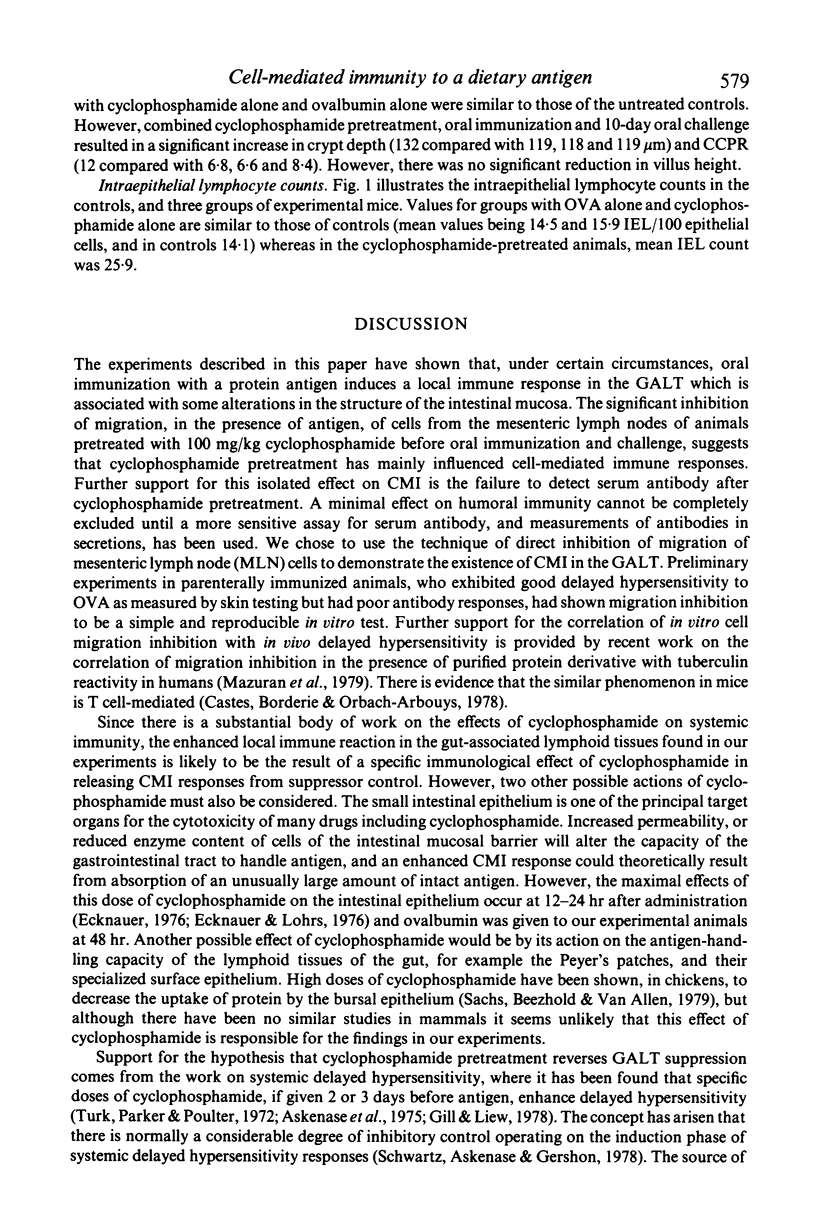
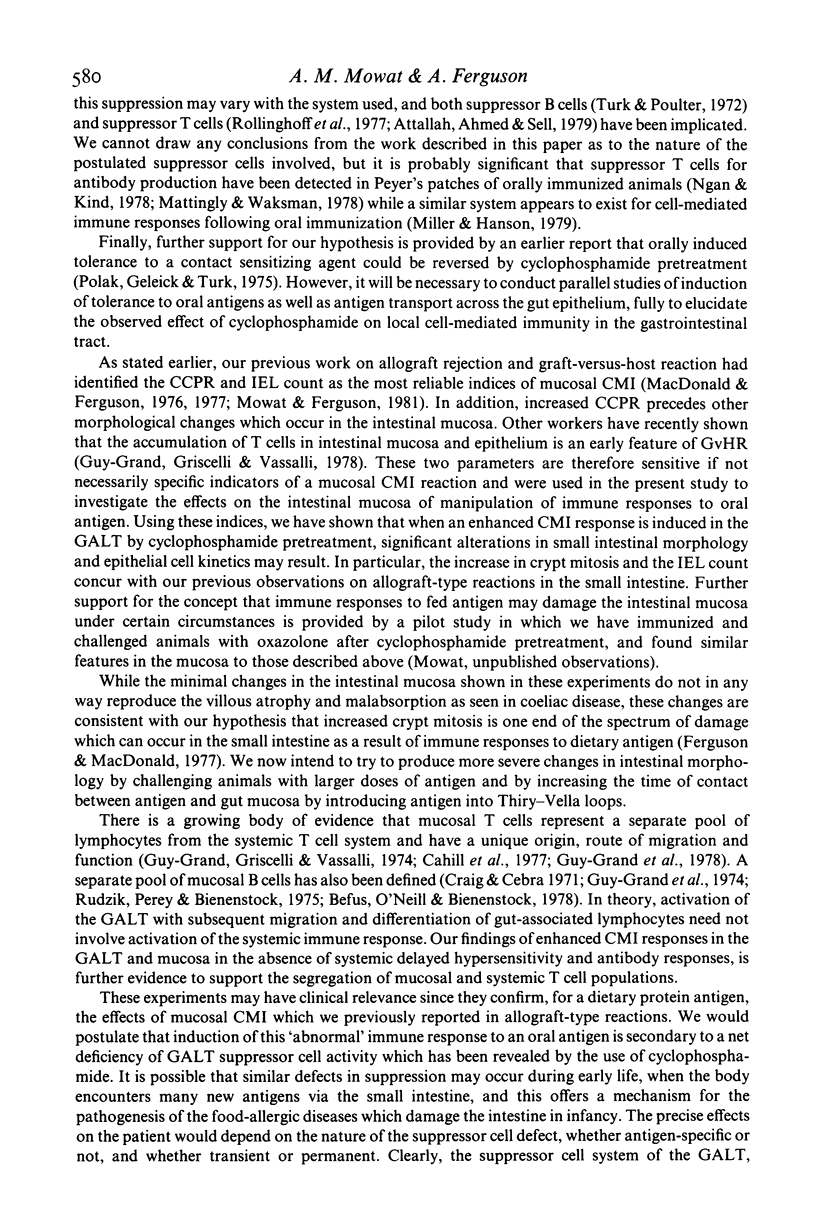
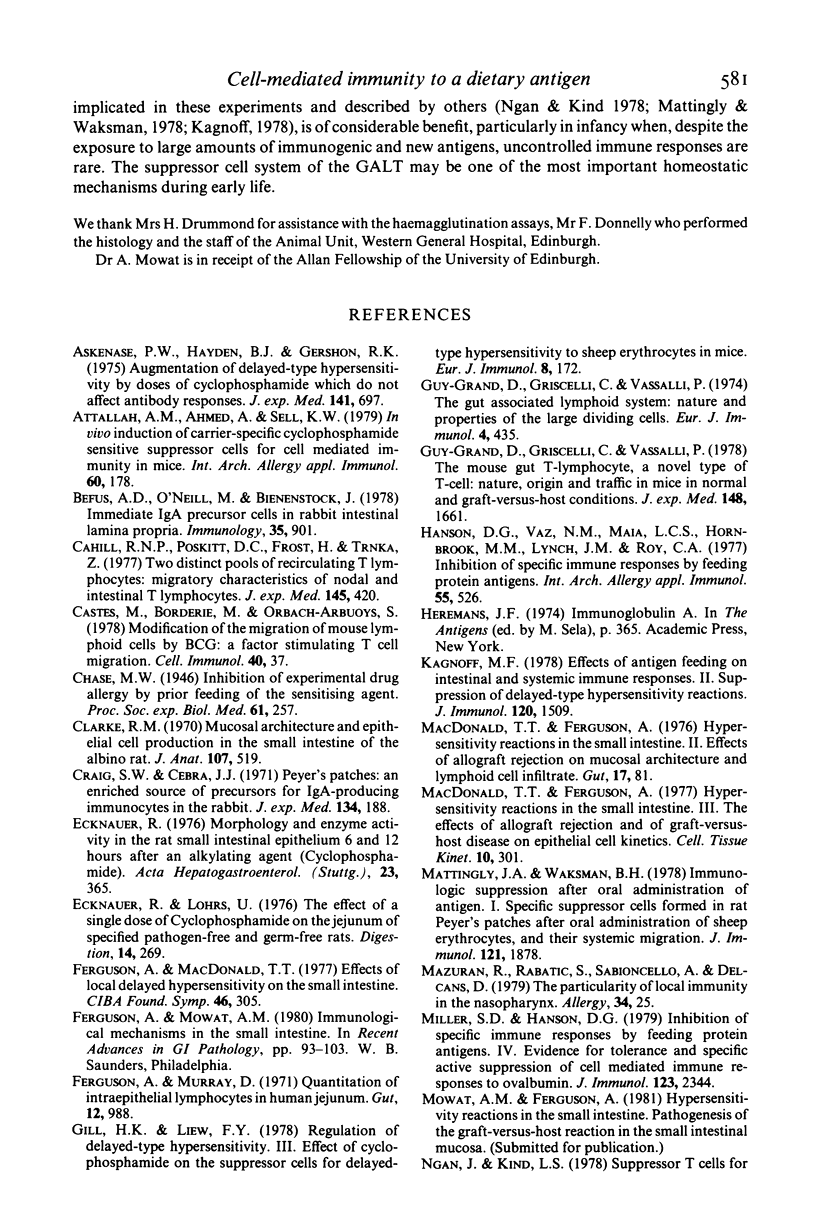
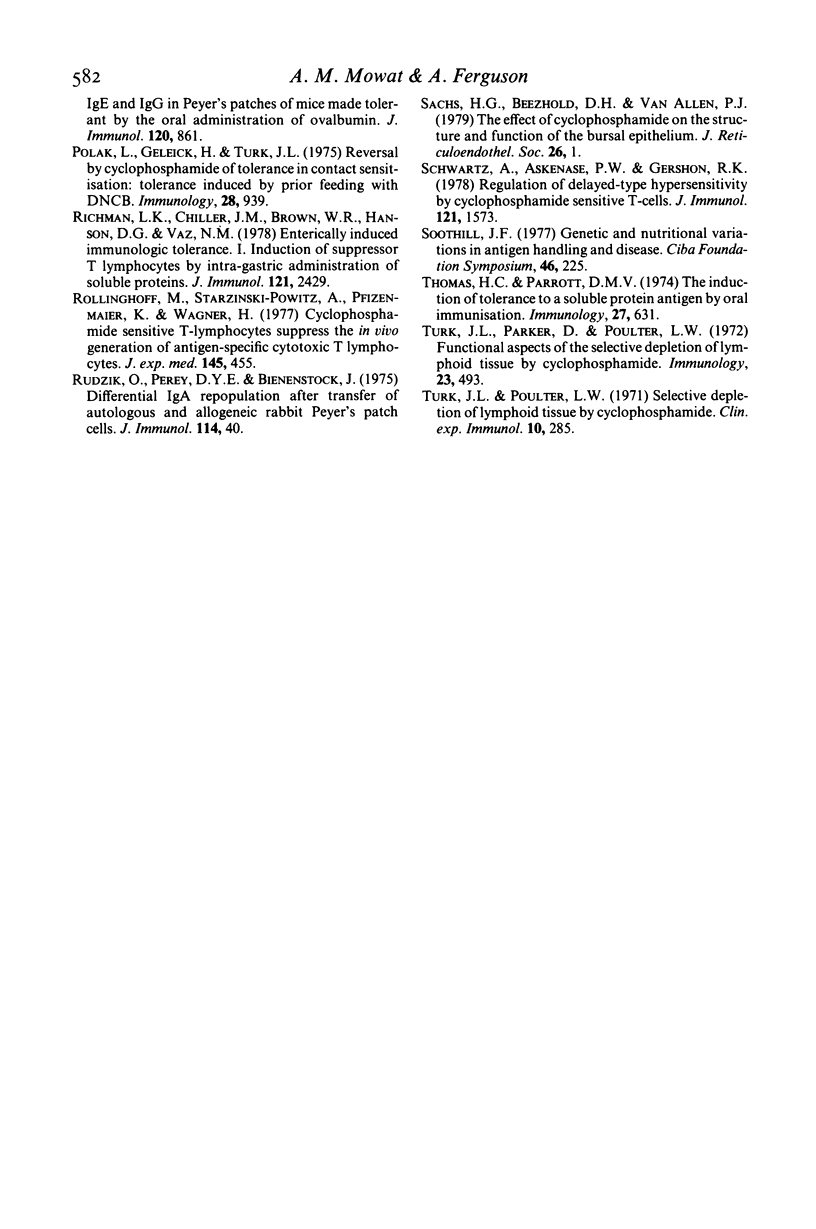
Selected References
These references are in PubMed. This may not be the complete list of references from this article.
- Askenase P. W., Hayden B. J., Gershon R. K. Augmentation of delayed-type hypersensitivity by doses of cyclophosphamide which do not affect antibody responses. J Exp Med. 1975 Mar 1;141(3):697–702. doi: 10.1084/jem.141.3.697. [DOI] [PMC free article] [PubMed] [Google Scholar]
- Attallah A. M., Ahmed A., Sell K. W. In vivo induction of carrier-specific cyclophosphamide-sensitive suppressor cells for cell-mediated immunity in mice. Int Arch Allergy Appl Immunol. 1979;60(2):178–185. doi: 10.1159/000232340. [DOI] [PubMed] [Google Scholar]
- Befus A. D., O'Neill M., Bienenstock J. Immediate IgA precursor cells in rabbit intestinal lamina propria. Immunology. 1978 Dec;35(6):901–906. [PMC free article] [PubMed] [Google Scholar]
- Cahill R. N., Poskitt D. C., Frost D. C., Trnka Z. Two distinct pools of recirculating T lymphocytes: migratory characteristics of nodal and intestinal T lymphocytes. J Exp Med. 1977 Feb 1;145(2):420–428. doi: 10.1084/jem.145.2.420. [DOI] [PMC free article] [PubMed] [Google Scholar]
- Castes M., Borderie N., Orbach-Arbouys S. Modification of the migration of mouse lymphoid cells by BCG: a factor stimulating T-cell migration. Cell Immunol. 1978 Sep 15;40(1):37–45. doi: 10.1016/0008-8749(78)90313-1. [DOI] [PubMed] [Google Scholar]
- Clarke R. M. Mucosal architecture and epithelial cell production rate in the small intestine of the albino rat. J Anat. 1970 Nov;107(Pt 3):519–529. [PMC free article] [PubMed] [Google Scholar]
- Craig S. W., Cebra J. J. Peyer's patches: an enriched source of precursors for IgA-producing immunocytes in the rabbit. J Exp Med. 1971 Jul 1;134(1):188–200. doi: 10.1084/jem.134.1.188. [DOI] [PMC free article] [PubMed] [Google Scholar]
- Ecknauer R., Löhrs U. The effect of a single dose of cyclophosphamide on the jejunum of specified pathogenfree and germfree rats. Digestion. 1976;14(3):269–280. doi: 10.1159/000197940. [DOI] [PubMed] [Google Scholar]
- Ecknauer R. Morphology and enzyme aktivity in rat small intestinal epithelium 6 and 12 hrs. after an alkylating agent (cyclophosphamide). Acta Hepatogastroenterol (Stuttg) 1976 Sep-Oct;23(5):365–371. [PubMed] [Google Scholar]
- Ferguson A., MacDonald T. T. Effects of local delayed hypersensitivity on the small intestine. Ciba Found Symp. 1977 Apr 26;(46):305–327. doi: 10.1002/9780470720288.ch15. [DOI] [PubMed] [Google Scholar]
- Ferguson A., Murray D. Quantitation of intraepithelial lymphocytes in human jejunum. Gut. 1971 Dec;12(12):988–994. doi: 10.1136/gut.12.12.988. [DOI] [PMC free article] [PubMed] [Google Scholar]
- Gill H. K., Liew F. Y. Regulation of delayed-type hypersensitivity. III. Effect of cyclophosphamide on the suppressor cells for delayed-type hypersensitivity to sheep erythrocytes in mice. Eur J Immunol. 1978 Mar;8(3):172–176. doi: 10.1002/eji.1830080306. [DOI] [PubMed] [Google Scholar]
- Guy-Grand D., Griscelli C., Vassalli P. The gut-associated lymphoid system: nature and properties of the large dividing cells. Eur J Immunol. 1974 Jun;4(6):435–443. doi: 10.1002/eji.1830040610. [DOI] [PubMed] [Google Scholar]
- Guy-Grand D., Griscelli C., Vassalli P. The mouse gut T lymphocyte, a novel type of T cell. Nature, origin, and traffic in mice in normal and graft-versus-host conditions. J Exp Med. 1978 Dec 1;148(6):1661–1677. doi: 10.1084/jem.148.6.1661. [DOI] [PMC free article] [PubMed] [Google Scholar]
- Hanson D. G., Vaz N. M., Maia L. C., Hornbrook M. M., Lynch J. M., Roy C. A. Inhibition of specific immune responses by feeding protein antigens. Int Arch Allergy Appl Immunol. 1977;55(1-6):526–532. doi: 10.1159/000231966. [DOI] [PubMed] [Google Scholar]
- Kagnoff M. F. Effects of antigen-feeding on intestinal and systemic immune responses. II. Suppression of delayed-type hypersensitivity reactions. J Immunol. 1978 May;120(5):1509–1513. [PubMed] [Google Scholar]
- MacDonald T. T., Ferguson A. Hypersensitivity reactions in the small intestine. 2. Effects of allograft rejection on mucosal architecture and lymphoid cell infiltrate. Gut. 1976 Feb;17(2):81–91. doi: 10.1136/gut.17.2.81. [DOI] [PMC free article] [PubMed] [Google Scholar]
- MacDonald T. T., Ferguson A. Hypersensitivity reactions in the small intestine. III. The effects of allograft rejection and of graft-versus-host disease on epithelial cell kinetics. Cell Tissue Kinet. 1977 Jul;10(4):301–312. [PubMed] [Google Scholar]
- Mattingly J. A., Waksman B. H. Immunologic suppression after oral administration of antigen. I. Specific suppressor cells formed in rat Peyer's patches after oral administration of sheep erythrocytes and their systemic migration. J Immunol. 1978 Nov;121(5):1878–1883. [PubMed] [Google Scholar]
- Mazuran R., Rabatić S., Sabioncello A., Dekaris D. Particularity of local immunity in the nasopharynx. Parallel study of surface receptors and cell-mediated immune responses in cells derived from palatine or pharyngeal tonsils and blood. Allergy. 1979 Feb;34(1):25–34. doi: 10.1111/j.1398-9995.1979.tb01997.x. [DOI] [PubMed] [Google Scholar]
- Miller S. D., Hanson D. G. Inhibition of specific immune responses by feeding protein antigens. IV. Evidence for tolerance and specific active suppression of cell-mediated immune responses to ovalbumin. J Immunol. 1979 Nov;123(5):2344–2350. [PubMed] [Google Scholar]
- Ngan J., Kind L. S. Suppressor T cells for IgE and IgG in Peyer's patches of mice made tolerant by the oral administration of ovalbumin. J Immunol. 1978 Mar;120(3):861–865. [PubMed] [Google Scholar]
- Polak L., Geleick H., Turk J. L. Reversal by cyclophosphamide of tolerance in contact sensitization. Tolerance induced by prior feeding with DNCB. Immunology. 1975 May;28(5):939–942. [PMC free article] [PubMed] [Google Scholar]
- Richman L. K., Chiller J. M., Brown W. R., Hanson D. G., Vaz N. M. Enterically induced immunologic tolerance. I. Induction of suppressor T lymphoyctes by intragastric administration of soluble proteins. J Immunol. 1978 Dec;121(6):2429–2434. [PubMed] [Google Scholar]
- Rudzik O., Perey D. Y., Bienenstock J. Differential IgA repopulation after transfer of autologous and allogeneic rabbit Peyer's patch cells. J Immunol. 1975 Jan;114(1 Pt 1):40–44. [PubMed] [Google Scholar]
- Röllinghoff M., Starzinski-Powitz A., Pfizenmaier K., Wagner H. Cyclophosphamide-sensitive T lymphocytes suppress the in vivo generation of antigen-specific cytotoxic T lymphocytes. J Exp Med. 1977 Feb 1;145(2):455–459. doi: 10.1084/jem.145.2.455. [DOI] [PMC free article] [PubMed] [Google Scholar]
- Sachs H. G., Beezhold D. H., Van Alten P. J. The effect of cyclophosphamide on the structure and function of the bursal epithelium. J Reticuloendothel Soc. 1979 Jul;26(1):1–9. [PubMed] [Google Scholar]
- Schwartz A., Askenase P. W., Gershon R. K. Regulation of delayed-type hypersensitivity reactions by cyclophosphamide-sensitive T cells. J Immunol. 1978 Oct;121(4):1573–1577. [PubMed] [Google Scholar]
- Soothill J. F. Genetic and nutritional variations in antigen handling and disease. Ciba Found Symp. 1977 Apr 26;(46):225–241. doi: 10.1002/9780470720288.ch11. [DOI] [PubMed] [Google Scholar]
- Thomas H. C., Parrott M. V. The induction of tolerance to a soluble protein antigen by oral administration. Immunology. 1974 Oct;27(4):631–639. [PMC free article] [PubMed] [Google Scholar]
- Turk J. L., Parker D., Poulter L. W. Functional aspects of the selective depletion of lymphoid tissue by cyclophosphamide. Immunology. 1972 Oct;23(4):493–501. [PMC free article] [PubMed] [Google Scholar]
- Turk J. L., Poulter L. W. Selective depletion of lymphoid tissue by cyclophosphamide. Clin Exp Immunol. 1972 Feb;10(2):285–296. [PMC free article] [PubMed] [Google Scholar]


